Jianfeng Feng
Stochastic Forward-Forward Learning through Representational Dimensionality Compression
May 22, 2025Abstract:The Forward-Forward (FF) algorithm provides a bottom-up alternative to backpropagation (BP) for training neural networks, relying on a layer-wise "goodness" function to guide learning. Existing goodness functions, inspired by energy-based learning (EBL), are typically defined as the sum of squared post-synaptic activations, neglecting the correlations between neurons. In this work, we propose a novel goodness function termed dimensionality compression that uses the effective dimensionality (ED) of fluctuating neural responses to incorporate second-order statistical structure. Our objective minimizes ED for clamped inputs when noise is considered while maximizing it across the sample distribution, promoting structured representations without the need to prepare negative samples. We demonstrate that this formulation achieves competitive performance compared to other non-BP methods. Moreover, we show that noise plays a constructive role that can enhance generalization and improve inference when predictions are derived from the mean of squared outputs, which is equivalent to making predictions based on the energy term. Our findings contribute to the development of more biologically plausible learning algorithms and suggest a natural fit for neuromorphic computing, where stochasticity is a computational resource rather than a nuisance. The code is available at https://github.com/ZhichaoZhu/StochasticForwardForward
DecoFuse: Decomposing and Fusing the "What", "Where", and "How" for Brain-Inspired fMRI-to-Video Decoding
Apr 01, 2025Abstract:Decoding visual experiences from brain activity is a significant challenge. Existing fMRI-to-video methods often focus on semantic content while overlooking spatial and motion information. However, these aspects are all essential and are processed through distinct pathways in the brain. Motivated by this, we propose DecoFuse, a novel brain-inspired framework for decoding videos from fMRI signals. It first decomposes the video into three components - semantic, spatial, and motion - then decodes each component separately before fusing them to reconstruct the video. This approach not only simplifies the complex task of video decoding by decomposing it into manageable sub-tasks, but also establishes a clearer connection between learned representations and their biological counterpart, as supported by ablation studies. Further, our experiments show significant improvements over previous state-of-the-art methods, achieving 82.4% accuracy for semantic classification, 70.6% accuracy in spatial consistency, a 0.212 cosine similarity for motion prediction, and 21.9% 50-way accuracy for video generation. Additionally, neural encoding analyses for semantic and spatial information align with the two-streams hypothesis, further validating the distinct roles of the ventral and dorsal pathways. Overall, DecoFuse provides a strong and biologically plausible framework for fMRI-to-video decoding. Project page: https://chongjg.github.io/DecoFuse/.
CineBrain: A Large-Scale Multi-Modal Brain Dataset During Naturalistic Audiovisual Narrative Processing
Mar 10, 2025Abstract:In this paper, we introduce CineBrain, the first large-scale dataset featuring simultaneous EEG and fMRI recordings during dynamic audiovisual stimulation. Recognizing the complementary strengths of EEG's high temporal resolution and fMRI's deep-brain spatial coverage, CineBrain provides approximately six hours of narrative-driven content from the popular television series The Big Bang Theory for each of six participants. Building upon this unique dataset, we propose CineSync, an innovative multimodal decoding framework integrates a Multi-Modal Fusion Encoder with a diffusion-based Neural Latent Decoder. Our approach effectively fuses EEG and fMRI signals, significantly improving the reconstruction quality of complex audiovisual stimuli. To facilitate rigorous evaluation, we introduce Cine-Benchmark, a comprehensive evaluation protocol that assesses reconstructions across semantic and perceptual dimensions. Experimental results demonstrate that CineSync achieves state-of-the-art video reconstruction performance and highlight our initial success in combining fMRI and EEG for reconstructing both video and audio stimuli. Project Page: https://jianxgao.github.io/CineBrain.
Making Your Dreams A Reality: Decoding the Dreams into a Coherent Video Story from fMRI Signals
Jan 16, 2025



Abstract:This paper studies the brave new idea for Multimedia community, and proposes a novel framework to convert dreams into coherent video narratives using fMRI data. Essentially, dreams have intrigued humanity for centuries, offering glimpses into our subconscious minds. Recent advancements in brain imaging, particularly functional magnetic resonance imaging (fMRI), have provided new ways to explore the neural basis of dreaming. By combining subjective dream experiences with objective neurophysiological data, we aim to understand the visual aspects of dreams and create complete video narratives. Our process involves three main steps: reconstructing visual perception, decoding dream imagery, and integrating dream stories. Using innovative techniques in fMRI analysis and language modeling, we seek to push the boundaries of dream research and gain deeper insights into visual experiences during sleep. This technical report introduces a novel approach to visually decoding dreams using fMRI signals and weaving dream visuals into narratives using language models. We gather a dataset of dreams along with descriptions to assess the effectiveness of our framework.
Uncertainty Quantification in Working Memory via Moment Neural Networks
Nov 21, 2024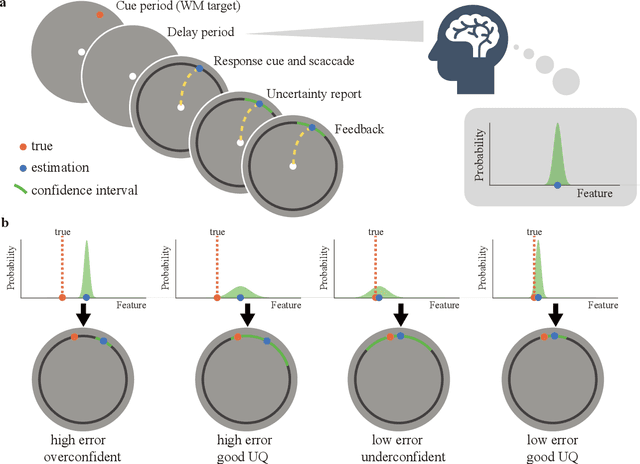
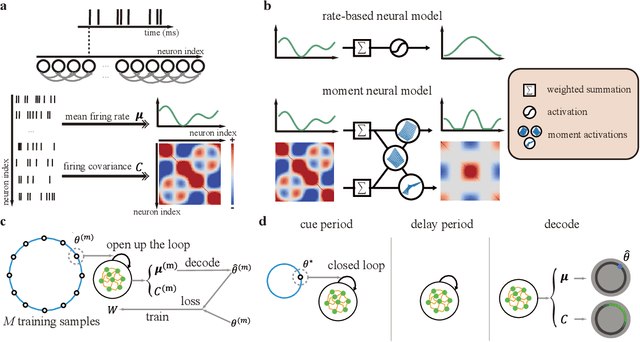
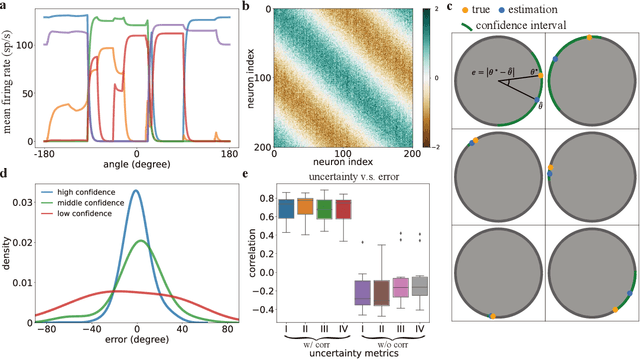
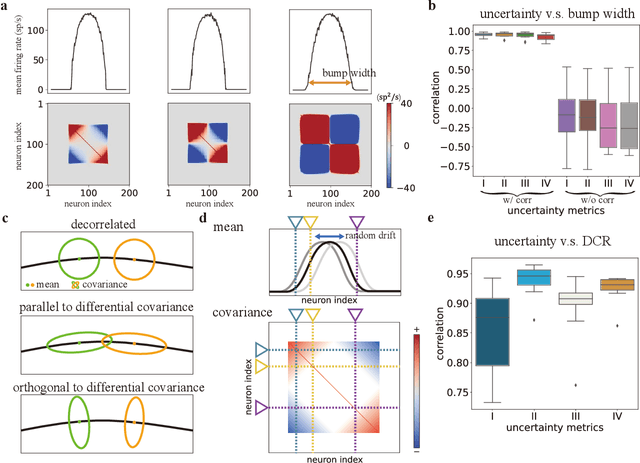
Abstract:Humans possess a finely tuned sense of uncertainty that helps anticipate potential errors, vital for adaptive behavior and survival. However, the underlying neural mechanisms remain unclear. This study applies moment neural networks (MNNs) to explore the neural mechanism of uncertainty quantification in working memory (WM). The MNN captures nonlinear coupling of the first two moments in spiking neural networks (SNNs), identifying firing covariance as a key indicator of uncertainty in encoded information. Trained on a WM task, the model demonstrates coding precision and uncertainty quantification comparable to human performance. Analysis reveals a link between the probabilistic and sampling-based coding for uncertainty representation. Transferring the MNN's weights to an SNN replicates these results. Furthermore, the study provides testable predictions demonstrating how noise and heterogeneity enhance WM performance, highlighting their beneficial role rather than being mere biological byproducts. These findings offer insights into how the brain effectively manages uncertainty with exceptional accuracy.
DG-SLAM: Robust Dynamic Gaussian Splatting SLAM with Hybrid Pose Optimization
Nov 13, 2024



Abstract:Achieving robust and precise pose estimation in dynamic scenes is a significant research challenge in Visual Simultaneous Localization and Mapping (SLAM). Recent advancements integrating Gaussian Splatting into SLAM systems have proven effective in creating high-quality renderings using explicit 3D Gaussian models, significantly improving environmental reconstruction fidelity. However, these approaches depend on a static environment assumption and face challenges in dynamic environments due to inconsistent observations of geometry and photometry. To address this problem, we propose DG-SLAM, the first robust dynamic visual SLAM system grounded in 3D Gaussians, which provides precise camera pose estimation alongside high-fidelity reconstructions. Specifically, we propose effective strategies, including motion mask generation, adaptive Gaussian point management, and a hybrid camera tracking algorithm to improve the accuracy and robustness of pose estimation. Extensive experiments demonstrate that DG-SLAM delivers state-of-the-art performance in camera pose estimation, map reconstruction, and novel-view synthesis in dynamic scenes, outperforming existing methods meanwhile preserving real-time rendering ability.
fMRI-3D: A Comprehensive Dataset for Enhancing fMRI-based 3D Reconstruction
Sep 17, 2024



Abstract:Reconstructing 3D visuals from functional Magnetic Resonance Imaging (fMRI) data, introduced as Recon3DMind in our conference work, is of significant interest to both cognitive neuroscience and computer vision. To advance this task, we present the fMRI-3D dataset, which includes data from 15 participants and showcases a total of 4768 3D objects. The dataset comprises two components: fMRI-Shape, previously introduced and accessible at https://huggingface.co/datasets/Fudan-fMRI/fMRI-Shape, and fMRI-Objaverse, proposed in this paper and available at https://huggingface.co/datasets/Fudan-fMRI/fMRI-Objaverse. fMRI-Objaverse includes data from 5 subjects, 4 of whom are also part of the Core set in fMRI-Shape, with each subject viewing 3142 3D objects across 117 categories, all accompanied by text captions. This significantly enhances the diversity and potential applications of the dataset. Additionally, we propose MinD-3D, a novel framework designed to decode 3D visual information from fMRI signals. The framework first extracts and aggregates features from fMRI data using a neuro-fusion encoder, then employs a feature-bridge diffusion model to generate visual features, and finally reconstructs the 3D object using a generative transformer decoder. We establish new benchmarks by designing metrics at both semantic and structural levels to evaluate model performance. Furthermore, we assess our model's effectiveness in an Out-of-Distribution setting and analyze the attribution of the extracted features and the visual ROIs in fMRI signals. Our experiments demonstrate that MinD-3D not only reconstructs 3D objects with high semantic and spatial accuracy but also deepens our understanding of how human brain processes 3D visual information. Project page at: https://jianxgao.github.io/MinD-3D.
RoDyn-SLAM: Robust Dynamic Dense RGB-D SLAM with Neural Radiance Fields
Jul 01, 2024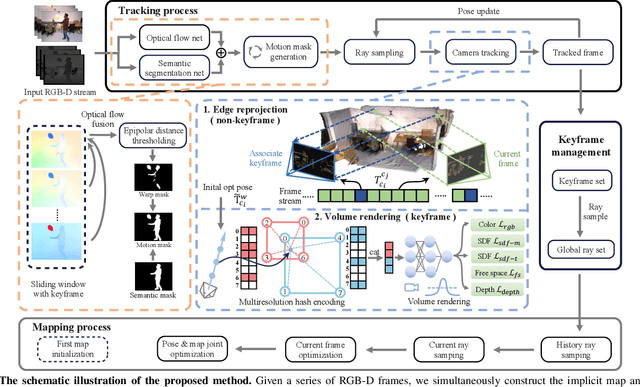

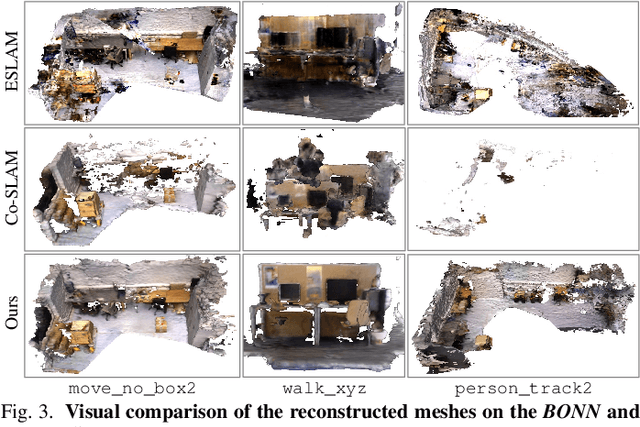
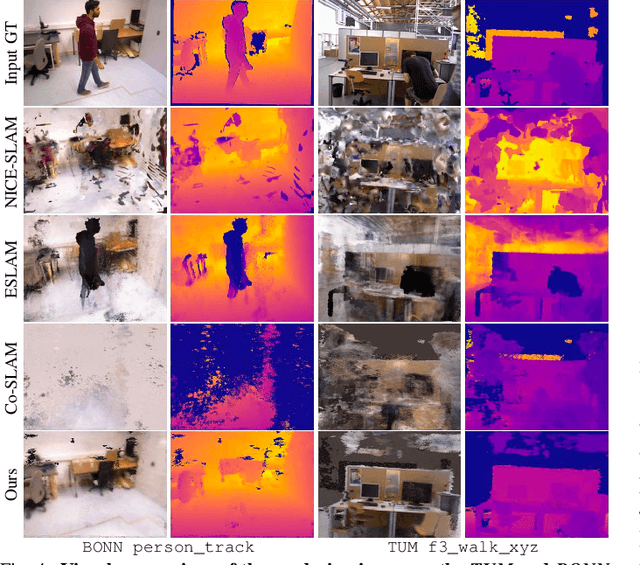
Abstract:Leveraging neural implicit representation to conduct dense RGB-D SLAM has been studied in recent years. However, this approach relies on a static environment assumption and does not work robustly within a dynamic environment due to the inconsistent observation of geometry and photometry. To address the challenges presented in dynamic environments, we propose a novel dynamic SLAM framework with neural radiance field. Specifically, we introduce a motion mask generation method to filter out the invalid sampled rays. This design effectively fuses the optical flow mask and semantic mask to enhance the precision of motion mask. To further improve the accuracy of pose estimation, we have designed a divide-and-conquer pose optimization algorithm that distinguishes between keyframes and non-keyframes. The proposed edge warp loss can effectively enhance the geometry constraints between adjacent frames. Extensive experiments are conducted on the two challenging datasets, and the results show that RoDyn-SLAM achieves state-of-the-art performance among recent neural RGB-D methods in both accuracy and robustness.
Automating the Diagnosis of Human Vision Disorders by Cross-modal 3D Generation
May 24, 2024



Abstract:Understanding the hidden mechanisms behind human's visual perception is a fundamental quest in neuroscience, underpins a wide variety of critical applications, e.g. clinical diagnosis. To that end, investigating into the neural responses of human mind activities, such as functional Magnetic Resonance Imaging (fMRI), has been a significant research vehicle. However, analyzing fMRI signals is challenging, costly, daunting, and demanding for professional training. Despite remarkable progress in artificial intelligence (AI) based fMRI analysis, existing solutions are limited and far away from being clinically meaningful. In this context, we leap forward to demonstrate how AI can go beyond the current state of the art by decoding fMRI into visually plausible 3D visuals, enabling automatic clinical analysis of fMRI data, even without healthcare professionals. Innovationally, we reformulate the task of analyzing fMRI data as a conditional 3D scene reconstruction problem. We design a novel cross-modal 3D scene representation learning method, Brain3D, that takes as input the fMRI data of a subject who was presented with a 2D object image, and yields as output the corresponding 3D object visuals. Importantly, we show that in simulated scenarios our AI agent captures the distinct functionalities of each region of human vision system as well as their intricate interplay relationships, aligning remarkably with the established discoveries of neuroscience. Non-expert diagnosis indicate that Brain3D can successfully identify the disordered brain regions, such as V1, V2, V3, V4, and the medial temporal lobe (MTL) within the human visual system. We also present results in cross-modal 3D visual construction setting, showcasing the perception quality of our 3D scene generation.
Towards free-response paradigm: a theory on decision-making in spiking neural networks
Apr 16, 2024Abstract:The energy-efficient and brain-like information processing abilities of Spiking Neural Networks (SNNs) have attracted considerable attention, establishing them as a crucial element of brain-inspired computing. One prevalent challenge encountered by SNNs is the trade-off between inference speed and accuracy, which requires sufficient time to achieve the desired level of performance. Drawing inspiration from animal behavior experiments that demonstrate a connection between decision-making reaction times, task complexity, and confidence levels, this study seeks to apply these insights to SNNs. The focus is on understanding how SNNs make inferences, with a particular emphasis on untangling the interplay between signal and noise in decision-making processes. The proposed theoretical framework introduces a new optimization objective for SNN training, highlighting the importance of not only the accuracy of decisions but also the development of predictive confidence through learning from past experiences. Experimental results demonstrate that SNNs trained according to this framework exhibit improved confidence expression, leading to better decision-making outcomes. In addition, a strategy is introduced for efficient decision-making during inference, which allows SNNs to complete tasks more quickly and can use stopping times as indicators of decision confidence. By integrating neuroscience insights with neuromorphic computing, this study opens up new possibilities to explore the capabilities of SNNs and advance their application in complex decision-making scenarios.
 Add to Chrome
Add to Chrome Add to Firefox
Add to Firefox Add to Edge
Add to Edge